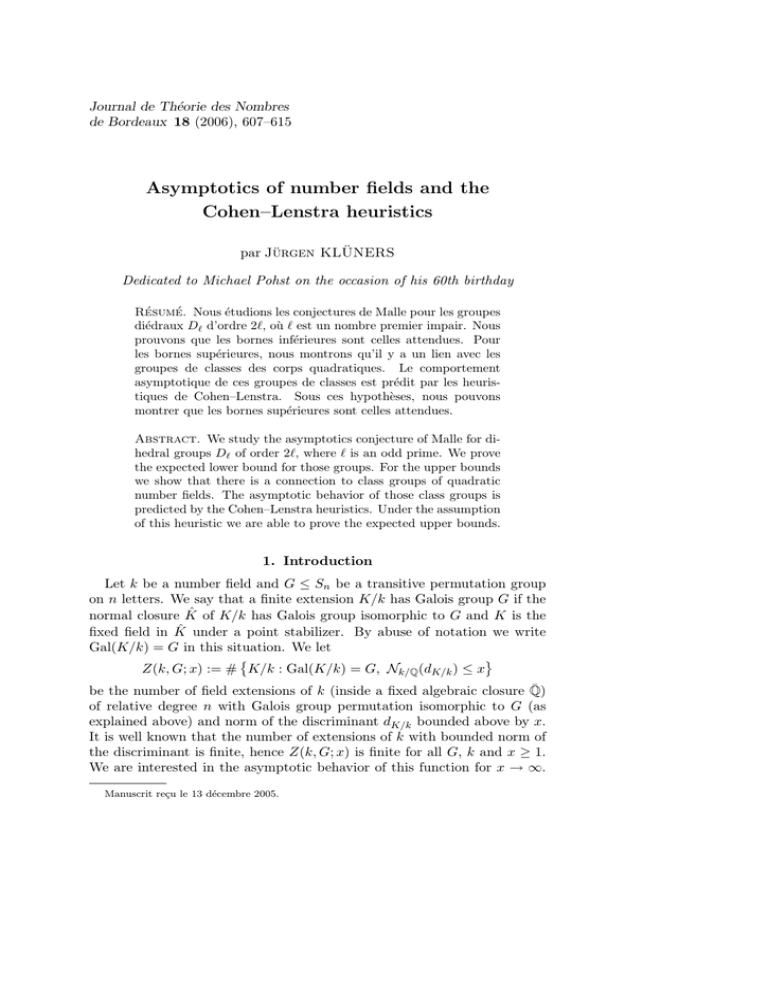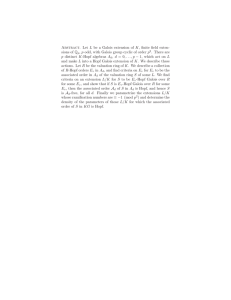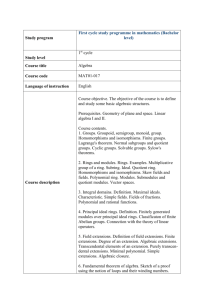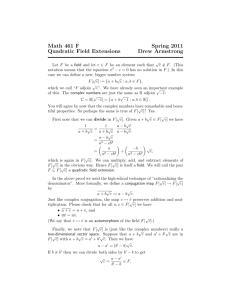Asymptotics of number fields and the Cohen–Lenstra heuristics
advertisement

Journal de Théorie des Nombres
de Bordeaux 18 (2006), 607–615
Asymptotics of number fields and the
Cohen–Lenstra heuristics
par Jürgen KLÜNERS
Dedicated to Michael Pohst on the occasion of his 60th birthday
Résumé. Nous étudions les conjectures de Malle pour les groupes
diédraux D` d’ordre 2`, où ` est un nombre premier impair. Nous
prouvons que les bornes inférieures sont celles attendues. Pour
les bornes supérieures, nous montrons qu’il y a un lien avec les
groupes de classes des corps quadratiques. Le comportement
asymptotique de ces groupes de classes est prédit par les heuristiques de Cohen–Lenstra. Sous ces hypothèses, nous pouvons
montrer que les bornes supérieures sont celles attendues.
Abstract. We study the asymptotics conjecture of Malle for dihedral groups D` of order 2`, where ` is an odd prime. We prove
the expected lower bound for those groups. For the upper bounds
we show that there is a connection to class groups of quadratic
number fields. The asymptotic behavior of those class groups is
predicted by the Cohen–Lenstra heuristics. Under the assumption
of this heuristic we are able to prove the expected upper bounds.
1. Introduction
Let k be a number field and G ≤ Sn be a transitive permutation group
on n letters. We say that a finite extension K/k has Galois group G if the
normal closure K̂ of K/k has Galois group isomorphic to G and K is the
fixed field in K̂ under a point stabilizer. By abuse of notation we write
Gal(K/k) = G in this situation. We let
Z(k, G; x) := # K/k : Gal(K/k) = G, Nk/Q (dK/k ) ≤ x
be the number of field extensions of k (inside a fixed algebraic closure Q̄)
of relative degree n with Galois group permutation isomorphic to G (as
explained above) and norm of the discriminant dK/k bounded above by x.
It is well known that the number of extensions of k with bounded norm of
the discriminant is finite, hence Z(k, G; x) is finite for all G, k and x ≥ 1.
We are interested in the asymptotic behavior of this function for x → ∞.
Manuscrit reçu le 13 décembre 2005.
Jürgen Klüners
608
Gunter Malle [10, 11] has given a precise conjecture how this asymptotic
should look like. Before we can state it we need to introduce some group
theoretic definitions.
Definition. Let 1 6= G ≤ Sn be a transitive subgroup acting on Ω =
{1, . . . , n} and g ∈ G. Then
(1) The index ind(g) := n − the number of orbits of g on Ω.
(2) ind(G) := min{ind(g) : 1 6= g ∈ G}.
(3) a(G) := ind(G)−1 .
(4) Let C be a conjugacy class of G and g ∈ C. Then ind(C) := ind(g).
The last definition is independent of the choice of g since all elements in
a conjugacy class have the same cycle shape. We define an action of the
absolute Galois group of k on the Q̄-characters of G. The orbits under this
action are called k–conjugacy classes. We remark that we get the ordinary
conjugacy classes when k contains all m-th roots of unity for m = |G|.
Definition. For a number field k and a transitive subgroup 1 6= G ≤ Sn
we define:
b(k, G) := #{C : C k-conjugacy class of minimal index ind(G)}.
Now we can state the conjecture of Malle [11], where we write f (x) ∼ g(x)
(x)
for limx→∞ fg(x)
= 1.
Conjecture 1.1. (Malle) For all number fields k and all transitive permutation groups 1 6= G there exists a constant c(k, G) > 0 such that
Z(k, G; x) ∼ c(k, G)xa(G) log(x)b(k,G)−1 ,
where a(G) and b(k, G) are given as above.
We remark that at the time when the conjecture was stated it was only
known to hold for all Abelian groups and the groups S3 and D4 ≤ S4 .
Example. Let ` be an odd prime and D` ≤ S` be the dihedral group of
order 2`. In this case the non-trivial elements of D` are of order 2 or `. In
the latter case the index is ` − 1. Elements of order 2 have 1 fixed point
and therefore the index is (` − 1)/2. All elements of order 2 are conjugated.
Therefore we get:
a(D` ) =
2
and b(k, D` ) = 1 for all k.
`−1
With the same arguments we get for D` (2`) ≤ S2` :
a(D` (2`)) =
1
and b(k, D` (2`)) = 1 for all k.
`
Asymptotics of number fields
609
In [7] we have given counter examples to the conjecture. In these counter
examples the log-factor is bigger than expected when certain subfields of
cyclotomic extensions occur as intermediate fields. Nevertheless the main
philosophy of this conjecture should still be true.
The goal of this paper is to prove the conjectured lower bounds for dihedral groups D` , where ` is an odd prime. We are able to prove the conjectured upper bounds when we assume a weak version of the Cohen–Lenstra
heuristics [3]. Furthermore we show that the Cohen–Lenstra heuristics is
wrong when the conjectured upper bound for dihedral groups is broken.
2. Dihedral groups of order 2`
In this section we collect some results about dihedral groups of order 2`,
where ` is an odd prime. Let k be a number field, M/k be an extension of
degree 2, N/M be an extension of degree ` such that N/k is normal with
Galois group D` . Denote by K/k a subfield of degree ` and define d := `−1
2 .
Then we get the following discriminant relation [6]:
(1)
dK/k = ddM/k NM/k (dN/M )1/2 .
N
2
K
D` (2`)
@
@
A
A C`
A
A
A
M
D`@
@
@
2
k
Using this discriminant relation the same approach will work for the group
D` (2`) ≤ S2` and D` ≤ S` . The reason is that up to isomorphy there exists
a unique field K/k with Galois group D` corresponding to (contained in) a
given N/k with Galois group D` (2`).
Denote by Dk,` the set of D` (2`)–extensions of k and by Ik the set of
ideals of k. Then we can define the following mapping:
Ψ : Dk,` → Ik2 , N/k 7→ dM/k , NM/k (dN/M )1/(2(`−1)) .
In order to define the 2(`−1)th root properly we need the following lemma:
Lemma 2.1. NM/k (dN/M ) is a 2(` − 1)th power in Ik .
Proof. N/M is a cyclic extension of prime degree. Therefore we have the
relation dN/M = c`−1
N/M , where cN/M is the conductor of N/M . Let p ⊆ Ok
be a prime ideal dividing NM/k (dN/M ). When p is split in M then both
prime ideals must divide cN/M which shows that p2(`−1) | NM/k (dN/M ).
610
Jürgen Klüners
When p is inert, i.e. pOM = P, we have NM/k (P) = p2 and we get the
desired result. The last case is when pOM = P2 . In this case P is wildly
ramified and therefore P2 | cN/M .
We remark that the statement of this lemma is much weaker than [1,
Theorem 10.1.25]. In this theorem it is proven that the conductor cN/M =
cOM for some ideal c ⊆ Ok . Using this result Lemma 2.1 follows easily.
Let N ∈ Dk,` and K be one of the subfields of N of degree `. Using
dN/k = d`M/k NM/k (dN/M ) and equation (1) we get:
(2)
dN/k = a` b2(`−1) and dK/k = ad b` ,
where Ψ(N ) = (a, b).
Clearly not every element of Ik2 is in the image of Ψ. Let (a, b) ∈ Ik2
be in the image of Ψ. Then a is squarefree when we ignore prime ideals
lying over 2. In other words p2 | a implies that the prime ideal p contains
2. The ideal b is squarefree when we ignore prime ideals lying above `.
Furthermore, the greatest common divisor of a and b is only divisible by
prime ideals lying above `. We remark that these statements are easy to
prove, e.g. see [1, Prop. 10.1.26]. Furthermore in the case k = Q it can be
proven that b itself must be squarefree.
The idea of our proof will be to count elements of Ik2 with the above
properties. Unfortunately Ψ is not injective. In the following we give upper
estimates for the number of quadratic extensions M/k corresponding to a
given ideal a. In a second step we will give upper estimates for the number
of extensions N/M which correspond to the pair (a, b) when we assume
that M/k is fixed. Altogether we get an upper estimate for the number of
elements in Dk,` which map to the same pair (a, b).
The following lemma is an easy consequence of [1, Theorem 5.2.9].
Lemma 2.2. Let k be a number field and a ⊆ Ok be an ideal. Denote by ru
the unit rank of k and by rc the 2–rank of the class group Clk . Then there
are at most 2rc +ru +1 quadratic extensions M/k which have discriminant
dM/k = a.
We remark that in the case k = Q we get the upper estimate 2 for the
number of extensions with the same discriminant. We remark that this
is the right answer for ideals of the form 8 · a · Z, where
a is odd
√
√ and
squarefree since in this case we have the extensions Q( 2a) and Q( −2a)
which correspond to our ideal.
Lemma 2.3. Let M/k be a quadratic extension such that the `–rank of
the class group of M is r. Then the number of D` (2`)–extensions N/M/k
which are subfields of the ray class field of bOM is bounded from above by
`r+ω(b) −1
, where ω(b) denotes the number of different prime factors of b.
`−1
Asymptotics of number fields
611
Proof. Define H := Gal(M/k) = hσi and consider the ray class group of
bOM modulo `th powers as an H-module. In [6, Sections 5 and 6] it is
proved that D` -extensions correspond to invariant subspaces of dimension
1 and eigenvalue −1. Let p be a prime ideal of Ok not lying over `. We
distinguish two cases. First we assume that p decomposes in M . In this
case the `-rank of the residue class ring OM /bOM is 2 or 0 depending on
` | |(Ok /p)× | or not. If the rank is 2 then σ interchanges the two prime
ideals lying over p and we find a 1-dimensional subspace with eigenvalue
1 and one with eigenvalue -1. In case that p is inert the `-rank of the ray
class group increases by at most 1. Similar arguments show the same result
for prime ideals p lying over `.
We remark that in the above lemma we give an upper estimate for all
C` –extensions N/M such that the conductor is a divisor of b.
Altogether we get the following upper bound for the number of fibers of
(a, b) under Ψ:
`r+ω(b) − 1
,
`−1
where r is the maximal `–rank of the class group of a quadratic extension
M/k of discriminant a and ru is the unit rank of k. Since our ground field
k is fixed, we have that 2rk2 (Clk )+ru +1 is a constant depending on k. We
will see that ω(b) will cause no problems. The critical part in this estimate
is the dependency on the class group of a field M which we do not know
explicitly.
In order to get good upper estimates we need to control the `–rank
of quadratic extensions. In order to simplify the situation let us restrict
to the case k = Q. In the general case we get similar results when we
assume the corresponding things for relative quadratic extensions M/k.
The Cohen–Lenstra–heuristic predicts the behavior of the class group of
quadratic number fields. Let us state a special case of this conjecture [3,
C6 and C10] which is only proven for ` = 3. In the following conjecture all
sums are over fundamental discriminants D. We define rD := rk` (ClQ(√D) ).
(3)
2rk2 (Clk )+ru +1 ·
Conjecture 2.4. (Cohen-Lenstra)
The average of `rD − 1 over all imaginary quadratic fields is 1, i.e.
P
rD − 1
−D≤x `
P
−→ 1 for x −→ ∞,
−D≤x 1
where only fundamental discriminants are considered in the sums. The
average of `rD − 1 over all real quadratic fields is `−1 .
It is well known that Z(Q, C2 ; x) ∼ c(C2 )x, where c(C2 ) is explicitly
known, see e.g. [2]. For our purposes it will be enough to assume the
Jürgen Klüners
612
following, where O is the usual Landau symbol.
X
(4)
`rD = O(x),
−D≤x
X
(5)
`rD = O(x).
D≤x
Theorem 2.5. Assume equations (4) and (5). Then for all odd primes `
we find constants c(`) and ĉ(`) such that:
Z(Q, D` ; x) ≤ c(`)x1/d = c(`)xa(D` ) , where d =
`−1
,
2
Z(Q, D` (2`); x) ≤ ĉ(`)x1/` = ĉ(`)xa(D` (2`)) .
Proof. Since Z is a principal ideal domain we can parameterize ideals in Z
by positive integers. Using equations (2) and (3) we get:
X
Z(Q, D` (2`), x) ≤
D` b2(`−1) ≤x
`ω(b)+rD − 1
+
`−1
X
(−D)` b2(`−1) ≤x
`ω(b)+rD − 1
,
`−1
where D runs over the fundamental discriminants, positive in the first sum
and negative in the second one. Let us restrict to the first sum. The other
one will be estimated in the same way.
X
X
`ω(b)+rD − 1
≤
`ω(b) `rD
`
−
1
` 2(`−1)
` 2(`−1)
≤x
D b
=
X
X
`ω(b)
b2(`−1) ≤x
≤x
D b
D≤
= c̃x1/`
(5)
x1/`
b2(`−1)/`
X
b2(`−1) ≤x
X
`rD ≤ c̃
b2(`−1) ≤x
`ω(b)
b2(`−1)/`
`ω(b) x1/`
b2(`−1)/`
= cx1/` .
The last sum converges since 2(` − 1)/` > 1. The result for Z(Q, D` , x)
follows in the same way when we sum over Dd b`−1 ≤ x.
As already remarked we can prove similar results for arbitrary ground
fields k when we assume corresponding results for the `–rank of the class
groups of quadratic extensions M/k. This becomes quite technical which
is the reason that we do not give this case here.
Conjecture 2.4 is proved for ` = 3 ([4]) which gives the following corollary.
Corollary 2.6. (1) Z(Q, D3 ; x) ≤ c(`)xa(D3 ) .
(2) Z(Q, D3 (6); x) ≤ c(`)xa(D3 (6)) .
Asymptotics of number fields
613
We remark that in the paper [4] the stronger result: Z(k, S3 ; x) ∼
c(k, S3 )x is obtained.
If we want to have unconditional upper bounds for dihedral groups, the
best thing we can do at the moment is the following:
`rD ≤ # ClQ(√D) = O(D1/2 log(D)).
If we use this estimate and use the method of the proof of Theorem 2.5 we
can prove the following.
Theorem 2.7. Let ` be an odd prime. Then for all > 0 we can find
constants c(`, ) and ĉ(`, ) such that:
Z(Q, D` ; x) ≤ c(`, )x3a(D` )/2+ ,
Z(Q, D` (2`); x) ≤ ĉ(`, )x3a(D` (2`))/2+ .
We remark that the O(D1/2 log(D)) bound for `rD can be improved to
O(log(D)1/2− ) assuming the generelized Riemann hypothesis, see [5].
3. Lower bounds
In this section we are interested in lower bounds for the number of fields
with dihedral Galois group. First we show that Cohen–Lenstra heuristic
also provides lower bounds for our asymptotics. We prove that the nonvalidity of equations (4) or (5) implies that the asymptotics conjecture for
the corresponding dihedral groups is wrong as well. This shows that the
class group of intermediate fields is an important obstruction. As in the
preceding section we assume k = Q to simplify everything. The following
lemma is well known.
Lemma 3.1. Let M/Q be a quadratic extension and N/M be a cyclic
unramified extension of degree `, where ` > 2 is prime. Then Gal(N/Q) =
D` (2`).
Proof. Gal(N/Q) is a transitive subgroup of the wreath product C` oC2 and
therefore one of the following groups: C` , D` (2`), or C` o C2 . Furthermore
Gal(N/Q) is generated by its inertia groups. All ramified primes have order
2 and the dihedral group is the unique group in this list which is generated
by elements of order 2.
Now we count dihedral extensions which are unramified over their quadratic subfield.
Y (Q, D` (2`); x) :=
#{N/Q : Gal(N/Q) = D` (2`), N (dN/Q ) ≤ x, N/M unramified}.
When we define Y (Q, D` ; x) in an analogous way we get:
Theorem 3.2. Assume Conjecture 2.4. Then
Jürgen Klüners
614
(1) Y (Q, D` (2`); x) ∼ cx1/` = cxa(D` (2`)) .
(2) Y (Q, D` ; x) ∼ c̃x2/(`−1) = c̃xa(D` ) .
Proof. As in the proof of Theorem 2.5 we consider real and complex quadratic fields separately.
X `rD − 1
X `rD − 1
Y (Q, D` (2`); x) =
+
`−1
`−1
D` ≤x
−D` ≤x
X
X
1
=
`rD − 1 +
`rD − 1 .
`−1
1/`
1/`
D≤x
−D≤x
Using conjecture 2.4 we get the formula in our theorem. The second one
can be proved in an analogous way.
Now assume that one of the equations (4) or (5) is wrong. Using the
same arguments as in the last proof we get a lower bound for dihedral
groups D` which contradicts the asymptotics conjecture 1.1.
In the last part of this paper we prove the lower bound for dihedral
groups unconditionally. We need the following result which is a special
case of [4, Theorem 4.2].
Proposition 3.3. Let ` be an odd prime and p, q ≡ 1 mod ` be two primes.
Then the number of quadratic extensions M/Q which are split in p and q
grows asymptotically like cx for some explicit constant c.
The quadratic extensions given in the last proposition have the nice
property that they admit a dihedral extension with bounded discriminant.
Lemma 3.4. Let M/Q be a quadratic extension which is split in two primes
p, q which are congruent to 1 mod ` for an odd prime `. Then there exists
an extension N/M which is at most ramified in primes lying above p and
q such that Gal(N/Q) = D` (2`).
Proof. Using Lemma 3.1 we can assume that ` - # ClM . Define a := pqOM
and consider the ray class group Cla . The multiplicative group of the
residue ring OM /a has `–rank 4. Furthermore the `–rank of the unit group
of OM is bounded above by 1. Using the canonical diagram for ray class
groups, see e.g. [9, p. 126], shows that the `–rank of Cla is at least 3. Let σ
be the generator of the Galois group of M/Q and denote by A` the F` [C2 ]–
module Cla / Cl`a , using the canonical action of σ. Now we can decompose
−
+
−
A` = A+
` ⊕ A` , where A` := {a ∈ A` | σ(a) = a} and A` := {a ∈ A` |
σ(a) = a−1 }. Using [6, Sections 5 and 6] we know that elements of A+
`
correspond to C2 × C` extensions and elements of A−
` correspond to D` (2`)
extensions N/Q. Since C2 ×C` extensions of Q admit a subfield with Galois
group C` over Q, we see that rk` (A` )+ = 2. This implies rk` (A−
` ) ≥ 1 and
therefore the existence of our D` (2`) extension.
Asymptotics of number fields
615
Let N/M be such an extension given in the above lemma. Then
(6) N (dN/Q ) ≤ N (dM )` (pq)2(`−1) and N (dK/Q ) ≤ N (dK )(`−1)/2 (pq)`−1 ,
where K is a subfield of N of degree `. Now we can prove the following
theorem.
Theorem 3.5. Let ` be an odd prime. Then there exist positive constants
c1 (`), c2 (`) such that
(1) Z(Q, D` ; x) ≥ c1 (`)xa(D` ) for x large enough.
(2) Z(Q, D` (2`); x) ≥ c2 (`)xa(D` (2`)) for x large enough.
Proof. Choose primes p, q ≡ mod `. For every quadratic extension M/Q
which is split in p and q we find a D` extension by Lemma 3.4 which has
bounded discriminant as given in (6). Clearly, for different M those D`
extensions are different. Using our discriminant formula we get:
X
X
1=
1,
Z(Q, D` ; x) ≥
D(`−1)/2 (pq)`−1 ≤x
D≤(x/(pq)`−1 )2/(`−1)
where we sum√only over fundamental discriminants D such that p and q
are split in Q( D). Using Proposition 3.3 we get that the last sum grows
asymptotically like cx2/(`−1) which proves our first formula. The second
one can be proved analogously.
References
[1] H. Cohen, Advanced Topics in Computational Number Theory. Springer, Berlin, 2000.
[2] H. Cohen, F. Diaz y Diaz, M. Olivier, Enumerating quartic dihedral extensions of Q.
Compositio Math. 133 (2002), 65–93.
[3] H. Cohen, H. W. Lenstra, Jr., Heuristics on class groups of number fields. In: Number theory, Noordwijkerhout 1983, volume 1068 of Lecture Notes in Math., pages 33–62.
Springer, Berlin, 1984.
[4] B. Datskovsky, D. Wright, Density of discriminants of cubic extensions. J. reine angew.
Math 386 (1988), 116–138.
[5] J. Ellenberg, A. Venkatesh, Reflection principles and bounds for class group torsion. To
appear in Int. Math. Res. Not.
[6] J. Klüners, C. Fieker, Minimal discriminants for small fields with Frobenius groups as
Galois groups. J. Numb. Theory 99 (2003), 318–337.
[7] J. Klüners, A counterexample to Malle’s conjecture on the asymptotics of discriminants.
C. R. Math. Acad. Sci. Paris 340 (2005), 411–414.
[8] J. Klüners, G. Malle, Counting nilpotent Galois extensions. J. Reine Angew. Math. 572
(2004), 1–26.
[9] S. Lang, Algebraic Number Theory. Springer, Berlin-Heidelberg-New York, 1986.
[10] G. Malle, On the distribution of Galois groups. J. Numb. Theory 92 (2002), 315–322.
[11] G. Malle, On the distribution of Galois groups II. Exp. Math. 13 (2004), 129–135.
Jürgen Klüners
Heinrich-Heine-Universität Düsseldorf,
Mathematisches Institut
Universitätsstr. 1, 40225 Düsseldorf, Germany
E-mail : klueners@math.uni-duesseldorf.de






